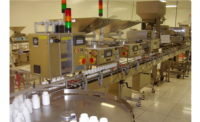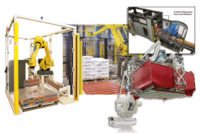Machinery Technology: Robotics & automation
Always improving the packaging line
Today’s machines answer the call for more and better technology.

SafeMove2 allows robots and operators to work closely together without possible harm.

Rebel-S 4-axis SCARA robots offer packagers a variety of mounting positons and an extended reach.

The Model 600 offers maximum flexibility to run multiple package styles with a variety of infeed options.

The Robox is a flexible end-of-line palletizer, designed to efficiently pack pallets of various product types.




Robotics and automation have long proved their value on packaging lines for all markets. The latest and greatest prove even more valuable, addressing key customer needs while increasing productivity.
To offer packagers a variety of mounting positons and an extended reach, Comau (comau.com) introduces Rebel-S, its own 4-axis SCARA robot, in five different models with a payload of 6kg and three different reaches.
What sets these new robots apart is that they offer a variety of mounting positions, and they utilize spacers to extend the robot’s reach. Rebel-S is available with reaches of 450-, 600- and 750mm. All three versions can be floor or wall mounted, while the versions with 600- and 750mm reach can also be configured for ceiling mounting. This flexibility in mounting position is enabled by the use of dual cabling options (either vertical or horizontal). With an extension kit composed of spacers and cables, the five models are effectively interchangeable.
All models are controlled by the R1C 19” rack-mounted controller, which can be integrated into a single cabinet to control an entire line. The robots are also available in the openROBOTICS version, where the robot is directly integrated into the existing machine/line automation controlled by B&R technologies.
Collaborative robots are a growing subsection of robotics. Safety and efficiency drive this trend as more companies are adopting robots into their packaging lines.
In response, ABB (abb.com) expands its collaborative portfolio with the introduction of SafeMove2, the latest generation of its safety-certified robot monitoring software. SafeMove2 delivers flexibility, space savings and cutting edge commissioning tools for greater productivity at a lower total investment cost.
Like the original SafeMove, first introduced in 2008, SafeMove2 includes a host of safety functions, including safe speed limits, safe standstill monitoring, safe axis ranges and position and orientation supervision. The new generation functionality encourages the development of innovative robot applications by integrating safety features directly into the robot controller. It allows robots and operators to work closely together without possible harm, by restricting the robot’s motion to only what is required for a specific task.
“To be efficient, robots must be able to move at speeds suited to the given application. At high speeds this can present a potential hazard for people working in the immediate vicinity. Historically, fences or cages have been used to separate man from machine in an effort to keep them out of harm’s way,” says Dr. Hui Zhang, head of product management, ABB Robotics.
With SafeMove2, true collaboration is possible. For example, if an operator needs to interact with the robot system, safety sensors can be incorporated into the robot cell to detect the person’s presence. After detected, SafeMove will either supervise the robot’s speed or monitor it while it is standing still. Once the person clears the zone, the robot can resume operation, resulting in less down time and increased productivity.
And while not everyone is specifically requesting a collaborative robot now, the demand is steadily growing as needs change in production plants.
“To date, we have not received many requests for this technology. Typically manufacturers who are coming to us are looking for complete automation solutions – where the packaging machine replaces multiple repetitive tasks. So therefore, one machine can be more cost-effective than several robots… Collaborative robots can offer ultimate flexibility and that is a priority for many of our customers…,” says Bryan Sinicrope, VP of sales and marketing, A-B-C Packaging Machine Corp.
Designed for use in the growing flexible packaging market, A-B-C’s (abcpackaging.com) new Model 600 robotic packer is an extension of the company’s line of pick and place packers.
The Model 600 offers maximum flexibility to run multiple package styles with a variety of infeed options, making this machine a good choice for packagers looking to upgrade from hand packing or moving from another package style. It is equipped with a high payload 2-axis robotic arm that can be programmed for virtually any packing configuration. The operator station offers complete control in a clear and concise interface, including setup, operation, real-time and historical status reports, maintenance alerts and fault detection for troubleshooting.
Changeover can be completed in less than 10 minutes by new product/pack selection at the operator station, and quick-change tooling reduces downtime for adjustments.
Reduced downtime and simple operation are key components to a successful robotics solution. New software for palletizing and case packing addresses these needs and more. Schneider Packaging Equipment Co. (schneiderpackaging.com) offers proprietary software to ensure efficient pack patterns for customer palletizing and case packing needs. The pattern generating setup software, introduced for Robox machines, automates layouts in palletizing. The standard manufacturer’s software is designed to be open-ended to accommodate multiple uses in the field. This new software can be tailored to fit the specific needs of customers, and new products can be set up in less than five minutes with quick adjustments being made to accommodate existing patterns for special unit loads. What’s more is that operation is simple and guided through the human-machine interface so nearly anyone on the floor can operate the software.
The Robox is a flexible end-of-line palletizer, designed to efficiently pack pallets of various product types. It features new improvements such as the over/under conveyor, which reduces the risk of injury by allowing the operator to stand safely outside of the cell and load a new pallet into the bottom of the conveyor. Once finished packing, the full pallet is lifted and conveyed out of the cell while the new pallet is received automatically. The robot never needs to stop operation.
Today’s robotics and automation technology offer customers even more benefits than they knew they needed. From space-savings to reduced downtime and collaboration, today’s machines and software have answered the call for superior production.
Looking for a reprint of this article?
From high-res PDFs to custom plaques, order your copy today!










